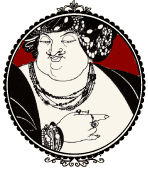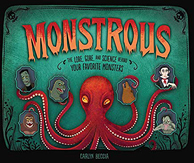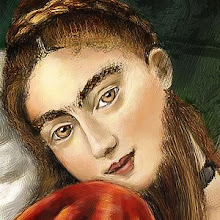The winners of past Golden Kite Awards are going on tour. Here is the info:
National Center for Children's Illustrated Literature
July 8, 2010 - October 1, 2010
102 Cedar Street, Abilene, TX 79601
Over 49 illustrators (including me) will be included in the event. If anyone is in the Abilene TX area and gets a chance to see it...let me know. I would love to go but that little bald guy with the milk demands is going to keep me at home.
Thursday, May 27, 2010
Wednesday, May 26, 2010
Brotherhood of Death
If you lived in 15th century Italy and found this scary cloaked man rattling his chains behind you then you were in some serious trouble. He was a member of the fraternity called The Brotherhood of Death and his job was to make a condemned prisoner's last days on earth more comfortable. He showed up in your prison cell before you were to be hanged, cut your hair, got that last meal, and then said a few prayers for your soul. Then, he followed behind you on your way to the gallows and sometimes collected alms for your soul. After your execution, he was also the guy who was responsible for cleaning up the executioner's mess - ie. collecting the rope and burying the corpse in a mass grave.
The executioner gets all the glamour while the Brotherhood of Death guy is just another one of those underappreciated worker bees of the Renaissance.
Sournces and Futher Reading:
Engraving - Cesare Vecellio
Jacob, P. L. Manners, Customs and Dress during the Middle Ages, London, Chapman and Hall, 1876.
The executioner gets all the glamour while the Brotherhood of Death guy is just another one of those underappreciated worker bees of the Renaissance.
Sournces and Futher Reading:
Engraving - Cesare Vecellio
Jacob, P. L. Manners, Customs and Dress during the Middle Ages, London, Chapman and Hall, 1876.
Thursday, May 20, 2010
Polydactyl Popes
 Yesterday, I asked readers to guess what was suspiciously off on the Sistine Madonna for this month's giveaway. Some of you are obviously on to my tricks. "Gabal" was right. The winged babies were a clever decoy to distract you from Sixtus IV. (Shown here).
Yesterday, I asked readers to guess what was suspiciously off on the Sistine Madonna for this month's giveaway. Some of you are obviously on to my tricks. "Gabal" was right. The winged babies were a clever decoy to distract you from Sixtus IV. (Shown here). But "Me" had the answer that I was thinking of (although I have to say Gabal that the Virgin's toe does look oddly forshortened to me too). "Me" - please email me and send me your address and I will get out your prize. (The contact link is under the scary lady to the left)
Answer: Pope Sixtus IV has an extra finger.
Art historians have long debated the meaning of the six fingers. It is doubtful that Raphael did it by accident or that Sixtus actually had six fingers. One theory is that he was making a play on the number "six" in his name and the Pope having a "sixth" sense. This painting is not the only one where that sly Raphael snuck in some extra digits.
In Raphael's Marriage of the Virgin, he gave Joseph an extra toe. Joseph is the figure on the right placing the ring on her finger and the extra toe is on the foot he is placing forward.
Raphael also gave Pope Julius II an extra finger in The Disputation on the Holy Sacrament. Detail of this painting below.
Thanks to everyone who played along. From now on you will be looking for that sixth digit in Raphael's paintings. Let me know if you know of any other incidents of art deformities. I like to use these examples in my school visits. Kids love to find hidden stuff in paintings!
I will have more giveaways next month and all newsletter subscribers are entered to win Ship of Rome by John Stack.
I will have more giveaways next month and all newsletter subscribers are entered to win Ship of Rome by John Stack.
Sources and Further Reading:
Heindel, Max. The Rosicrucian Cosmo-Conception Mystic Christianity, Book Jungle, 2006
Wednesday, May 19, 2010
Giveaway Time! Test your Art Smarts
I have not done a giveaway in a while. I have some pretty smart art historians that visit this blog occasionally so I have a feeling that this one is going to be too easy, but here goes...
Sometimes, even famous Renaissance artists don't always get their paintings perfect. What in Raphael's Sistine Madonna is not quite right?
Regular readers of this blog know that I mistrust winged babies. They are always up to some sort of chicanery. Here are those incorrigible cherubs. Ask them. They know the answer.
The first person to answer correctly will win Philppa Gregory's The White Queen. Just leave your answer in the comment field below. If no one guesses the correct answer then a winner will be selected on "best creative answer." Contest ends this Saturday. Hints will follow tomorrow if no one guesses it today.
You must be in the US or Canada to play. Good luck...
About The White Queen
My husband gave me this book as a mother's day gift not realizing that I already had read it. I think The White Queen was her best yet. It's one of those quick reads. It covers Elizabeth Woodville. But if you like that era in history, I also recommend The Stolen Crown: The Secret Marriage that Forever Changed the Fate of England by Susan Higginbotham.
Monday, May 17, 2010
New England Society of Children's Book Writers and Illustrators Conference
You know that feeling you get when you know you have forgotten something important. You get heart palpitations, sweaty palms and images of your house burning down from that oven you are sure you left on. I had it all weekend. Accept I didn’t forget my keys, my wallet or even to brush my hair (common in my case). I forgot my kids.
Early Saturday morning, armed with caffeine and a well-intentioned GPS, I made my escape to the New England Society of Children's Book Writers and Illustrators Conference (NESCBWI) and not even the sound of three screaming children could make me turn around. (a 6 month old, a 2 year old, and a token husband)
Here were some of my favorite talks (I could not attend all of them):
New York Times bestselling author, Cynthia Leitich Smith kicked us out of our morning stupor with her personal journey of how she came to write about pixies, shapeshifters and vampires. She had lots of good advice on what to expect if you quit that cushiony desk job to become a children's book writer. She also talked about how to reinvent yourself once you get cast into one genre. That's something I could relate to. Cynthia is definitely a Raucous Royal...one of those renaissance women who could split dna, find a cure for cancer AND get kids reading. She was also really funny which was good because I just needed to laugh to make me forget about the kids I had abandoned.
If you have a teen with a penchant for shapeshifting then you must check out some of her books.
Deborah Sloan and Mitali Perkins gave an amazing talk on “Managing Your Online Presence.” My head is spinning with all I learned. I had no clue what Facebook could do nor did I know that there are PRIVACY SETTINGS that you MUST set. I didn’t know you could feed your blog into facebook. And I didn’t know you can make lists of contacts organizing people with helpful titles like, “fellow history geek buddies” (that would be anyone who reads this blog) and “old high school boyfriends who might want me dead” and “people who have an epiphany that I have the same last name as them.” Currently, I really only use facebook for people I know and people who have the same last name as me. (My family is from Sicily. You just don’t ignore friend requests from Sicilians). I still don’t know how to “friend” someone unless I see one of those nifty “friend suggestions.” I am going to go figure that out today. (I can hear the chorus of duuuuuuuuhs over cyberspace right now)
Check out Mitali Perkins blog. I am pretty sure that it is done by her evil twin because there is no way she could write such amazing books and still have time to have this good of a blog.
Leda Schubert gave a really amusing and insightful talk on “Telling it True.” Leda and I share a love of circus history. And you must check out her incredible book – Ballet of the Elephants. I had to leave Leda’s talk half way through to pump milk (more on that later) but I left with some great tips.
Melissa Stewart gave one of those inspirational + informative + humorous = darn good talk on “It’s a Great Time for Nonfiction”. She talked POV, Style and Tone. I learned that studies are showing that kids (especially boys) prefer reading nonfiction and that kids that read nonfiction are more likely to graduate. She gave some interesting examples of how different writers tuned conventional formats on their head.
Marla Frazee….Gasp, Faint, Throw up. (in that order). I wasn’t really planning to go to the NESCBWI conference until I heard she was speaking. Marla Frazee is my idol. I am pretty sure that a 13 year old asking a Jonus Brother (the extra cute one) for his autograph would have been calmer than I was. Marla and Allyn Johnston gave a talk showing examples of picture books that they have worked on. It is hard to describe, but seeing her revision process really made me understand how good narrative art works. I must confess that sometimes my art is pretty, but doesn't tell enough of a story. It's something that I plan to work on.
Which brings me to Carrie Jones, Jo Knowles and Kate Messner's talk on blogging. They advised not being disparaging on your blog, not giving out too much information, not letting your blog keep you from writing your book, and not always talking about yourself. (check, check, check and check.) I guess I will have to work on that too.
Lastly, I really enjoyed Cynthia Levison’s talk on writing for Nonfiction Magazines. I have never written for magazines and had no clue where to start. I am still not sure if my writing style would work in a magazine format, but I might give it a try some day.
MOOOOOOOOOOOOO
The only dark moment in the conference was that unfortunate incident where I almost drove my lucky pencil through the eye of the woman at the front desk of the lobby. (Really, I love my lucky pencil. I would have hated to get blood all over it. )
This story borders on the lines of TMI, but I am hopped up on caffeine right now so I am going to tell it anyway. Since I am still nursing, I needed to store my breast milk in the hotel lobby’s fridge. So I asked one of the staff if I could use the hotel's fridge. Simple request. Done all the time. Never a problem. Well, she immediately looked at me as if I had just asked to grow the ebola virus next to her Little Debbie Snack Cakes. Now, I must give a visual. I did NOT give her visible containers of my bodily fluids. I gave her a small 6 x 6 cooler. Shown below:
I was then sent scrambling asking strangers if I could store my son’s next meal in their fridge. Thankfully, the Applewood Restaurant let me use their fridge. Thank you. Thank you. Thank you to the Applewood Restaurant.
So other than this one undignified moment, The NESCBWI Conference was another great event. Just leave your commercial breast pump at home. Lactating writers not welcome.
Early Saturday morning, armed with caffeine and a well-intentioned GPS, I made my escape to the New England Society of Children's Book Writers and Illustrators Conference (NESCBWI) and not even the sound of three screaming children could make me turn around. (a 6 month old, a 2 year old, and a token husband)
Here were some of my favorite talks (I could not attend all of them):
New York Times bestselling author, Cynthia Leitich Smith kicked us out of our morning stupor with her personal journey of how she came to write about pixies, shapeshifters and vampires. She had lots of good advice on what to expect if you quit that cushiony desk job to become a children's book writer. She also talked about how to reinvent yourself once you get cast into one genre. That's something I could relate to. Cynthia is definitely a Raucous Royal...one of those renaissance women who could split dna, find a cure for cancer AND get kids reading. She was also really funny which was good because I just needed to laugh to make me forget about the kids I had abandoned.
If you have a teen with a penchant for shapeshifting then you must check out some of her books.
Deborah Sloan and Mitali Perkins gave an amazing talk on “Managing Your Online Presence.” My head is spinning with all I learned. I had no clue what Facebook could do nor did I know that there are PRIVACY SETTINGS that you MUST set. I didn’t know you could feed your blog into facebook. And I didn’t know you can make lists of contacts organizing people with helpful titles like, “fellow history geek buddies” (that would be anyone who reads this blog) and “old high school boyfriends who might want me dead” and “people who have an epiphany that I have the same last name as them.” Currently, I really only use facebook for people I know and people who have the same last name as me. (My family is from Sicily. You just don’t ignore friend requests from Sicilians). I still don’t know how to “friend” someone unless I see one of those nifty “friend suggestions.” I am going to go figure that out today. (I can hear the chorus of duuuuuuuuhs over cyberspace right now)
Check out Mitali Perkins blog. I am pretty sure that it is done by her evil twin because there is no way she could write such amazing books and still have time to have this good of a blog.
Leda Schubert gave a really amusing and insightful talk on “Telling it True.” Leda and I share a love of circus history. And you must check out her incredible book – Ballet of the Elephants. I had to leave Leda’s talk half way through to pump milk (more on that later) but I left with some great tips.
Melissa Stewart gave one of those inspirational + informative + humorous = darn good talk on “It’s a Great Time for Nonfiction”. She talked POV, Style and Tone. I learned that studies are showing that kids (especially boys) prefer reading nonfiction and that kids that read nonfiction are more likely to graduate. She gave some interesting examples of how different writers tuned conventional formats on their head.
Marla Frazee….Gasp, Faint, Throw up. (in that order). I wasn’t really planning to go to the NESCBWI conference until I heard she was speaking. Marla Frazee is my idol. I am pretty sure that a 13 year old asking a Jonus Brother (the extra cute one) for his autograph would have been calmer than I was. Marla and Allyn Johnston gave a talk showing examples of picture books that they have worked on. It is hard to describe, but seeing her revision process really made me understand how good narrative art works. I must confess that sometimes my art is pretty, but doesn't tell enough of a story. It's something that I plan to work on.
Which brings me to Carrie Jones, Jo Knowles and Kate Messner's talk on blogging. They advised not being disparaging on your blog, not giving out too much information, not letting your blog keep you from writing your book, and not always talking about yourself. (check, check, check and check.) I guess I will have to work on that too.
Lastly, I really enjoyed Cynthia Levison’s talk on writing for Nonfiction Magazines. I have never written for magazines and had no clue where to start. I am still not sure if my writing style would work in a magazine format, but I might give it a try some day.
MOOOOOOOOOOOOO
The only dark moment in the conference was that unfortunate incident where I almost drove my lucky pencil through the eye of the woman at the front desk of the lobby. (Really, I love my lucky pencil. I would have hated to get blood all over it. )
This story borders on the lines of TMI, but I am hopped up on caffeine right now so I am going to tell it anyway. Since I am still nursing, I needed to store my breast milk in the hotel lobby’s fridge. So I asked one of the staff if I could use the hotel's fridge. Simple request. Done all the time. Never a problem. Well, she immediately looked at me as if I had just asked to grow the ebola virus next to her Little Debbie Snack Cakes. Now, I must give a visual. I did NOT give her visible containers of my bodily fluids. I gave her a small 6 x 6 cooler. Shown below:
She said “No, I am sorry I can’t do that.” I asked why. She just repeated that she could not do that. I explained to her that my son would not have anything to eat tomorrow if I didn’t get that milk home safely. No, I have no extra. The kid is 21 lbs. He eats more than a small baby calf. He is a WICKED big baby. (said in my best Boston accent)
I was then sent scrambling asking strangers if I could store my son’s next meal in their fridge. Thankfully, the Applewood Restaurant let me use their fridge. Thank you. Thank you. Thank you to the Applewood Restaurant.
So other than this one undignified moment, The NESCBWI Conference was another great event. Just leave your commercial breast pump at home. Lactating writers not welcome.
Tuesday, May 11, 2010
Mistress of the Poggio Catino Palazzo
Imagine waking up in your own baronial palazzo in the quiet town of Poggio Catino 45 km northeast of Rome. You are greeted each morning to panoramic views of bucolic hilltops and the warm sun melting your worries away. You have a steaming cappuccino in one hand (or a glass of vino in my dream sequence) and a good book (of course) in the other hand. No screaming kids. No obnoxious bosses. Just you and the sweet aroma of crocus flowers filling the air (and possibly a handsome naked serving boy named Fabio). Your world could not be more peaceful.
Then, you find a 16th century skeleton loitering in your basement. Named the “Poggio Catino Skeleton”, it was discovered in 1933 in a cell beneath the ruins of the tower by its owner, Vincenzo Biraghi. It is believed to be a woman and judging by the shackles around her wrists and ankles, her bent knee position, and her less than cheerful living quarters...she most likely bit it hard.
According to one legend, the woman was the wife of Geppo Colonna, the lord of Poggio Catino. Supposedly, Miss Colonna had an illicit affair with another nobleman of Poggio Catino. As they say in Italy...idea stupida! Her jealous husband discovered the dalliance and locked her up in an underground cell where she most likely starved to death.
You can read more about the Poggio Catino Skeleton and see several other creepy artifacts at the Museo Criminologico.
Sunday, May 9, 2010
Raucous Royal of the Month, Caterina Sforza: Daughter of Perdition
"...more is always said then the real truth"
- Caterina Sforza
On August 1483, the 21 year old Caterina Sforza rode up to the Castel Sant’ Angelo as shouts of “Duca! Duca!” cut through the stifling heat. Clad in a green satin dress with two yards of fabric flowing behind her, a long black cape, and a curved falchion (sword) in her clenched fist, she looked like an avenging angel sent from the underworld. The people of Rome pushed and clamored to get a glimpse of the golden-haired warrior princess who had held the city of Rome for thirteen days against her enemies’ opposition. Weeks earlier, Pope Sixtus IV had died and the Eternal City had erupted into chaos with mob riots and warring families trying to cut each others throats. Her husband, Girolamo Riaro, had met the turmoil by hightailing it out of Rome, but Caterina had bravely ordered the garrison to defend the city and galloped out on horseback in the midst of melee.
To the people of Rome, she was the vision of strength, courage and Sforza determination. She was also 7 months pregnant.
 Caterina Sforza was born in 1462 as the illegitimate daughter of Galeazzo Maria Sforza and Lucrezia Landriani. She was given a humanist education along with learning hunting and the martial arts skills which would become so feared that one contemporary wrote, “when she had a weapon in her hand, she was hard and cruel.” (1) She most likely learned brutality from her father who once executed a poacher by having him swallow an entire hare including fur. With another, he had him nailed to his coffin....alive. One of his favorite past times was to visit the local convents at night and rape the nuns. Over time, Galeazzo's actions tended to garner him a few too many enemies in high places and in 1474, he was assassinated by the Visconti.
Caterina Sforza was born in 1462 as the illegitimate daughter of Galeazzo Maria Sforza and Lucrezia Landriani. She was given a humanist education along with learning hunting and the martial arts skills which would become so feared that one contemporary wrote, “when she had a weapon in her hand, she was hard and cruel.” (1) She most likely learned brutality from her father who once executed a poacher by having him swallow an entire hare including fur. With another, he had him nailed to his coffin....alive. One of his favorite past times was to visit the local convents at night and rape the nuns. Over time, Galeazzo's actions tended to garner him a few too many enemies in high places and in 1474, he was assassinated by the Visconti.Three years later, Caterina married Girolamo Riaro, nephew (wink wink) of Pope Sixtus.* As long as Sixtus was in power, Caterina and Girolamo were treated like the Hollywood golden couple. Girolamo was elevated to the Lordship of Forli while he lived amongst the decadence of Rome. Meanwhile, Sixtus was in the process of remaking Rome as the envy of the world. Work had just begun on the Sistine Chapel (named after Sixtus) along with several other construction projects of new churches, bridges and streets. Art flourished. The Vatican Library was founded. Rome had become the place to be. It was also a cesspit of corruption with a few strong families tenuously holding on to power through nepotism and simony. (The term nepotism comes from the Medieval Italian word for nephew- nepote.)
Then Sixtus died in 1484. The glory days for Caterina were over. Pope Innocent VIII was elected and as a token bone for getting kicked out of Rome, he let Caterina and Girolamo keep Forli to rule. The denizen of Forli didn't exactly appreciate the gesture. After enduring months of tax increases, the opposing Orsi family threw Girolamo out a window. They then took Caterina’s six children as hostage.
Yet Caterina appeared unfazed by the hostage situation. When the Orsi threatened to hack her children to pieces if she did not surrender the strategic fortress of Rocca di Ravlaldino, Caterina simply lifted up her skirts and told her enemies to keep them because she had the “mold” to make more. This skirt lifting incidence is retold by many biographers including Machiavelli who wrote in his Discourses:
“She reproached them from the wall with the death of her husband, threatening them with every kind of revenge. And to show that she did not care about her children, she uncovered to them her gen- ital members, saying that she still had means for producing more children.” (2)
First hand accounts tend to be less colorful then Machiavelli’s version of events. According to Leone Cobelli who was actually present during the siege, Caterina, simply made “four figs” at her captives. (The four figs was a not-so-nice gesture made by placing the thumb between the index finger and middle finger while making a fist - your Renaissance equivalent of giving someone the finger.) Cobelli fails to mention Caterina lifting her skirts or telling her captives to keep her children.
Other accounts describe Caterina as claiming she was pregnant and that her unborn son would avenge her enemies. (A threat to be taken seriously in Renaissance Italy) One thing is certain. Caterina certainly didn’t fall into weeping histrionics at the sight of her children taken hostage. Was her seemingly apathetic stance a clever bluff or the actions of a heartless mother?
Whichever it was, it worked. With the help of Uncle Ludovico Sforza (il moro) she regained control of Forli and spent the next few years as regent for her young son, Ottaviano. During this time, she brushed up on her alchemy skills, wrote a book of beauty recipes and best of all, devised ways to avenge her husband’s death. She got really creative with the patriarch of the Orsi family, Andrea Orsi. She and had him dragged through the streets tied to a horse’s tail and then ordered his heart cut out and his body dismembered.
Those were fun times for Caterina. When the Borgia Pope Alexander VI took charge, everything went to hell in a handbasket. Citing Caterina's salacious conduct in taking lovers, he ordered that Forli be given to his son, Francescolotto Gibo. (This punishment seems kind of harsh when you consider that Francescolotto was no choir boy.) Then in 1498, Alexander’s son Cesare Borgia struck a deal with king Louis XII where Louis promised to drive out the ruling families of Romagna in exchange for claims to Milan and Naples.
Declaring that 'should I have to perish, I want to perish like a man,' Caterina defended Ravaldino fortress from Caesar and his thugs by using one of oldest Borgia tricks in the book...poison. (3) She sent Alexander some chatty letters that she sealed with a kiss and rubbed on some local plague victims. Unfortunately, her terrorist attack on the Pope failed when spies revealed the plot to Alexander. Cesare promptly had Caterina imprisoned where she was mostly likely raped and tortured. Caterina was release in 1501 and died 7 years later of pneumonia.
Caterina Sforza: The Artist Muse
She is immortalized by countless artists including Botticelli in his The Three Graces (Caterina is believed to be the grace in the far right) and also several portrayals of the Virgin and Child. Leonardo was believed to have met her around 1500 and she may have been his model for the Mona Lisa. (There are some slight similarities seen in the paintings below, but most art scholars still credit the sitter's identity to Lisa Gherardini Giocondo. Personally, I don't see the similarities.) Caterina was also good friends with Michelangelo and she became one of the few people he trusted.
Caterina Sforza: The Mother
Despite being called a “Virago”, “The Tiger of Forlì” and “Daughter of Perdition” by Pope Alexander VI, Caterina sure was fertile. She had 11 children, popping them out practically every reproductive year of her life. But Caterina is not exactly your Hallmark card mother. While she undeniably had tremendous political acumen, history has also branded her as the uncaring shrew who in a moment of passion, labeled her womb as the artillery in her quest for revenge. I had wanted to include Caterina Sforza in my book The Raucous Royals, but I had to cut her when I realized there was just no way to tackle her skirt lifting rumor delicately enough for a younger audience. Today, Caterina Sforza is reduced to a buxom action figure in the video game, Assassins Creed with a proclivity for more skirt lifting. It hardly does her any justice. At least in the game she tries to win back her children.
Happy Mother's Day to all my mom readers. And remember if your kids don't worship the ground you walk on today then take a Machiavellian stance and just threaten to whip up another batch.
Notes:
* Girolamo was most likely Sixtus's son. "Nephew" became a euphemism for son in the 15th century.
(1) Jones, page 181
(2) Machiavelli, Discourses 3.6, CWO: 444
(3) Fraser p. 201
Sources and Further Reading:
Jones, David E. Women warriors: a history, Potomac Books, 2002.
Fraser, Antonia. Warrior Queens, The Legends and the Lives of the Women Who Have Led Their Nations in War, Anchor, 1990.
Julia L. Hairston, Renaissance Quarterly, Vol. 53, No. 3 (Autumn, 2000), pp. 687-712. The University of Chicago Press on behalf of the Renaissance Society of America
Breisach, Ernst, Caterina Sforza: A Renaissance Virago, University of Chicago Press, 1968
Labels:
Alexander VI,
Caterina Sforza,
Cesare Borgia
Monday, May 3, 2010
Joan of Arc: Courageous, Saintly, Rich in Protein
 “A source of fiber” “rich in protein” and containing moderate amounts of “iron and vitamins B1 and B2”. These are not the words that most historians would attach to the mythological Joan of Arc. This is the ad copy for JOAN of ARC Kidney Beans which according to the web site are also, “great in chili, salads, soups and casseroles. And when it comes to Latin American and Creole cuisine, Joan of Arc is a real leader!”
“A source of fiber” “rich in protein” and containing moderate amounts of “iron and vitamins B1 and B2”. These are not the words that most historians would attach to the mythological Joan of Arc. This is the ad copy for JOAN of ARC Kidney Beans which according to the web site are also, “great in chili, salads, soups and casseroles. And when it comes to Latin American and Creole cuisine, Joan of Arc is a real leader!” Undeniably, Joan of Arc can sell a whole lot of beans. Although not a single contemporary portrait of her has survived, her face has been plastered on everything from brie cheese to great works of art, books and Hollywood dramas. She is by far the most popular heroine in childrens books and for good reason. At a time when most teens really don’t fully know themselves, Joan of Arc emerges as the iconic heroine of “just do it” determination. This sassy, firecracker of a girl is the social outcast and miss popularity all rolled up in one. Who could possibly resist Jules-Eugène Lenepveu’s larger than life girl, vaingloriously defying the odds as she thrusts her banner to heaven?
Mark Twain spent 12 years writing his novel, Personal Recollections of Joan of Arc and considered it his best work. Critics disagreed. They said Twain was “infatuated” with Joan and accused him of “romanticizing” her story. I still don’t completely understand Joan so I hope any Joan experts that come across my neophyte attempts to retell her story will forgive my stumbling in areas. If Joan could make Twain stumble, then I am in for a rough ride.
Dark Days for the City of Lights
Joan’s story begins in one of the darkest time of the One Hundred years war. Wolves roamed the country side. Plagues ravaged the population. France was in need of a serious morality boost, but there was no Eiffel Tower. No croissants. No cute little beret clad kitties with French accents. No “France.” Carved up like a Christmas turkey, a good chunk of France was controlled by the Burgundians whose loyalty was to the English.
Add to that misery some messy dynastic issues. The king and queen of France, Charles VI and Isabeau of Bavaria had signed the Treaty of Troyes which basically cut their son, Charles VII out of the succession in favor of their daughter, Catherine. They then married Catherine to the English king, Henry V thereby making him and any sons they would have the next kings of France. Isabeau even claimed Charles VII was not her son (and people believed her). Then Henry V and Charles VI dropped dead about the same time leaving Henry’s young son, Henry VI and Charles VII fighting over the crown. In order for Charles VII to be considered the rightful king of France, he had to be crowned at Reims. One problem. Reims was controlled by the English and Charles could barely afford a decent pair of hose so forget about funding an army.
 Now, it follows with one of my favorite Raucous Royals maxims – Those that have the best gizmos will always come out on top. On one side, was the Burgundians and the English led by John, the Duke of Bedford, uncle to the baby Henry VI. They had these snazzy longbows that could easily shoot over 100 yards into enemy lines and puncture a helmet. On the other side, we have the French Armagnacs headed by Bernard d'Armagnac and loyal to the Dauphin, Charles VII. They had some pretty stupid looking hats.* English armies had managed to destroy French armies two to three times their size. It wasn’t exactly a fair battle.
Now, it follows with one of my favorite Raucous Royals maxims – Those that have the best gizmos will always come out on top. On one side, was the Burgundians and the English led by John, the Duke of Bedford, uncle to the baby Henry VI. They had these snazzy longbows that could easily shoot over 100 yards into enemy lines and puncture a helmet. On the other side, we have the French Armagnacs headed by Bernard d'Armagnac and loyal to the Dauphin, Charles VII. They had some pretty stupid looking hats.* English armies had managed to destroy French armies two to three times their size. It wasn’t exactly a fair battle.At the time, a much believed prophecy told of France being lost by a woman and saved by a maiden. The first half of the prophecy was believed to have come true. (Isabeau had lost France) Now, people were waiting for the second half – the maiden to appear.
Stay tuned for part two of Joan of Arc
*ok I am being slightly unfair. The French had longbows too. They just couldn’t figure out how to turn them into hats.
Sources will be listed at end of posts.
Labels:
Charles VII,
Isabeau of Bavaria,
Joan of Arc
Subscribe to:
Comments (Atom)





























